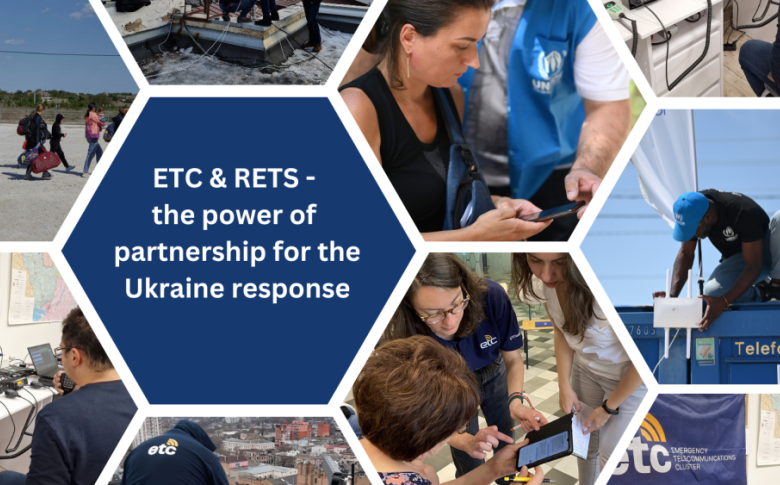Communications connectivity a lifeline for people in country and on the move

By Tom Mallah
This story originally appeared on ReliefWeb
The conflict in Ukraine shows us how large population displacements can spill over into neighboring countries, compounding the complexity and coordination of humanitarian responses. It is also a real example of how the Emergency Telecommunications Cluster (ETC) and the Refugee Emergency Telecommunications Sector (RETS) complement each other's mandates through the power of partnership.
Humanitarian responses vary in scale and complexity. Natural disasters and conflicts can displace people internally as well as into neighboring countries.
Regardless of the context, information, and communications technology (ICT) is an essential enabler of humanitarian action. It not only empowers emergency response, coordination, and delivery, but also helps shorten distances and gives people access to information on their road to recovery. Staying connected is a lifeline for those that have been forced to flee their homes and leave everything behind.
While ICTs have transformed humanitarianism in profound ways, connectivity across large operational areas is still not taken for granted. Communications networks and infrastructure are often destroyed or disrupted in emergencies.
Cooperation among UN agencies, governments, and the private and public sectors is crucial to keeping people connected.
Through their respective mandates, the World Food Programme (WFP)-led Emergency Telecommunications Cluster (ETC) and the Refugee Emergency Telecommunications Sector (RETS), led by UNHCR, the UN Refugee Agency, help fill connectivity gaps and increasingly support access to information for affected communities.
Connecting people through different mandates
The cluster system was endorsed in 2005 by the UN Inter-Agency Standing Committee (IASC) to address accountability gaps around key humanitarian services in non-refugee emergency responses.[1] Clusters were first activated during an earthquake response in Pakistan that same year. Since then, the Emergency Telecommunications Cluster (ETC) has provided shared communications services to the humanitarian community in 43 emergencies around the world.
In emergencies where people flee to another country, humanitarian coordination is ensured through the Refugee Coordination Model[2] .
RETS provides connectivity and access to information under this model. It was launched in 2016. "UNHCR's priority at the onset of an emergency is to ensure that the basic needs of forcibly displaced people are met quickly and effectively. IT is a key component for enabling the delivery and coordination of any humanitarian response," says Massoumeh Farman Farmaian, Chief of IT EPRS, UNHCR. RETS is currently active in 12 countries.
While RETS and the ETC serve different groups of people, they are both built on solid partnerships. The complex situation in Ukraine perhaps best illustrates the complementarity between ETC and RETS mandates.
Ukraine, a mixed situation
It has been over a year since the conflict in Ukraine escalated, killing, or injuring over 20,000 civilians and causing millions to flee their homes to neighboring provinces or seek refuge in bordering countries.
RETS was activated for the response to the Ukraine emergency in March 2022[UB1] . With many Ukrainians looking for safety in Hungary, Moldova, Poland, Romania, and Slovakia, RETS has been providing connectivity at major crossing points and in refugee-hosting countries.
Blue Dot Hubs (set up by UNHCR and UNICEF) are safe havens for people on the move and give verified, up-to-date information about safe travel, what to expect in neighboring countries, and how to access essential services. RETS connectivity makes these services possible.
In Moldova for instance, RETS connectivity allows UNHCR to disperse cash to refugees and links people with accommodation centers. RETS connectivity is also crucial for children, helping them "continue their education and not to lose an academic year" says Francesca Bonelli, UNHCR Representative for Moldova.
As of March 2023, over 62 000 humanitarians and 139 000 refugees have used RETS connectivity services in Poland, Slovakia, Hungary, Romania, and Moldova.
Meanwhile, the ETC was activated in Ukraine in March 2022, supporting humanitarian operations in Kyiv, Lviv, Mukachevo, Odessa and Dnipro.
Despite daily uncertainties in Ukraine, secure communications networks, and VHF radios are reliable because of the ETC. Because of these tools, three hundred humanitarians have been kept safe while reaching those in need.
The ETC chatbot vBezpetsi gives people remaining in Ukraine access to reliable information on their humanitarian entitlements. To date, nearly 19,000 internally displaced people have contacted vBezpetsi through mobile applications like Viber and Telegram.
Working towards a common user experience
Because of the inherent challenges and fluidity of humanitarian situations, connectivity and user experiences vary between operational areas and countries.
That is something RETS and the ETC are looking to improve. "The relationship between RETS and the ETC shows the synergies that can be gained in the humanitarian community," says Caroline Teyssier, Global Deputy ETC Coordinator "We not only train in some of the same courses and deploy some of the same technology in the field but we also share expertise and lessons learned. And increasingly, we're looking at developing a more coherent user experience between RETS and the ETC."
Connectivity during emergencies is only impactful if it can be accessed by those furthest behind.
As the situation in and around Ukraine illustrates, humanitarian organizations and their partners must be increasingly flexible.
Connecting humanitarians and affected communities on the move is closely linked to technology's ability to adapt to the realities on the ground. Beyond connectivity though, both the ETC and RETS show that partnerships are indispensable for having a real impact in humanitarian emergencies. Having different mandates does not preclude working together to make a difference.
------------------------------
[[1]] IASC Using the Cluster Approach to Strengthen Humanitarian Response, 2006
[[2]] UNHCR, 2022
EPRS deployed an IT Emergency Coordinator between 6-14 February 2022 to conduct a preparedness assessment mission, make recommendations for enhanced IT readiness, and align the operation with UNHCR minimum and advanced preparedness protocols. [[UB1]]